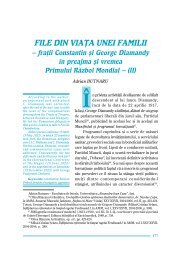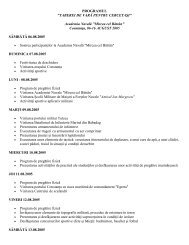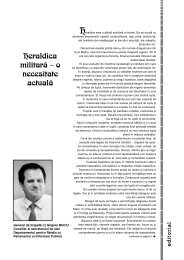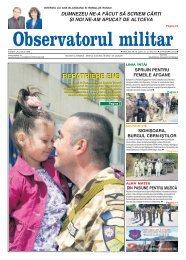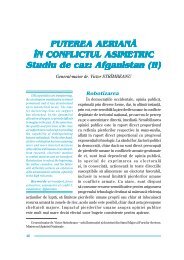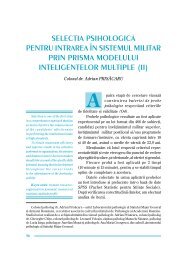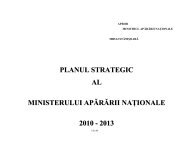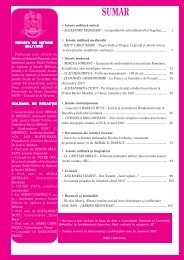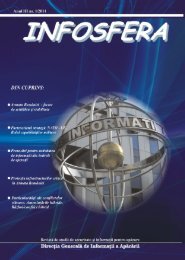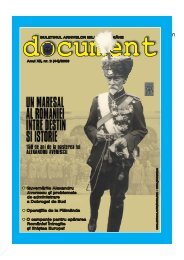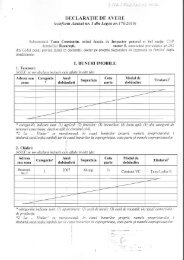Romanian Military Thinking
Romanian Military Thinking
Romanian Military Thinking
You also want an ePaper? Increase the reach of your titles
YUMPU automatically turns print PDFs into web optimized ePapers that Google loves.
86<br />
<strong>Romanian</strong> <strong>Military</strong> <strong>Thinking</strong> ~ 4/2007<br />
to work under the Tsar definitively. For this<br />
reason he was accused of treason by the<br />
French Generals. He was nominated<br />
by the Tsar as General of Division,<br />
aide-de-camp and his adviser and went with<br />
him to International Meetings. In addition,<br />
he became preceptor of the Russian crown<br />
prince. Finally, after having retired to private<br />
life in Belgium and then in France, he<br />
suggested to Napoleon III the plan aimed<br />
at winning the French-Piedmontese war<br />
of 1859 against Austria.<br />
The period he spent at the Tsar’s service<br />
was very fruitful. In 1830 he published<br />
«Tableau Analytique des principales<br />
combinaisions de la<br />
guerre et des leurs<br />
rapports avec la politique<br />
des Etats», where the art<br />
of war is divided into five<br />
branches: the politics<br />
of war (which artificially<br />
distinguishes itself from<br />
the military policy),<br />
strategy (or art/science of moving the<br />
masses in the theatre of war), the great<br />
tactics of manoeuvres and fighting<br />
(which involves moving the armies in the<br />
battlefield), the art of the engineer including<br />
the attack and the defence of strongholds<br />
and the tactics of detail. Both the strategy<br />
and the «great tactics of manoeuvres<br />
and fighting» are summarized in the<br />
concentration of forces at a crucial point.<br />
The strategy concerns the compilation<br />
of the plan of campaign, which involves the<br />
analysis of 15 factors; the plan of campaign<br />
is carried out by «the great tactics». Strategy<br />
– unlike the tactics – is an exact science,<br />
more than an art. The «tactics of detail»<br />
includes the training of personnel and the<br />
employment of minor units in the fighting.<br />
“Both Jomini and<br />
Clausewitz are real<br />
interpreters of the<br />
Napoleonic model and<br />
both of them consider<br />
strategy as dependent<br />
on politics”<br />
In «Tableau», h e<br />
introduced for the<br />
first time the term<br />
“logistics”, but this<br />
new branch was not<br />
considered as a part<br />
of the art/science<br />
of war yet and he<br />
gave it the role<br />
of «handmaid of French infantry at Waterloo<br />
strategies», which consists in organizing<br />
the movement and the stationing of troops<br />
according to the strategy. The current<br />
contents of logistics are included in the<br />
military administration, whereas the<br />
branches of artillery<br />
and Corps of Engineers<br />
maintain a logisticaladministrative<br />
organization.<br />
The most important<br />
and complete work<br />
is «Précis de l’art de la<br />
guerre ou nouveau<br />
tableau analytique des principales<br />
combinaisions de la stratégie, de la grande<br />
tactique et de la politique militaire» (two<br />
volumes – 1838). In disagreement with<br />
Clausewitz (who is not cited in the opening<br />
chapter when he refers to the masters<br />
of the art of war), but making concessions<br />
to his anti-dogmatism, he confirms and<br />
deepens the contents of his previous works<br />
and, for the first time, defines logistics as<br />
an autonomous branch of the art/science<br />
of war, which for him is more science than<br />
art – contradicting himself – and has as<br />
immutable basis, as point of reference<br />
that should always be considered,<br />
some principles motivated by historical<br />
experience. This process makes the<br />
formulation of a complete theory of war




